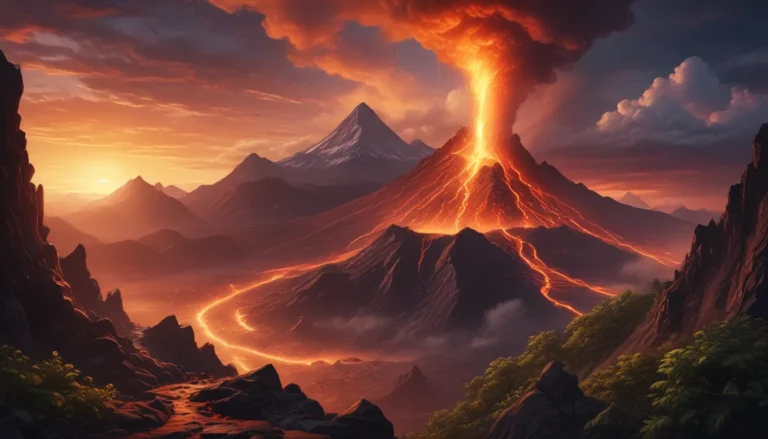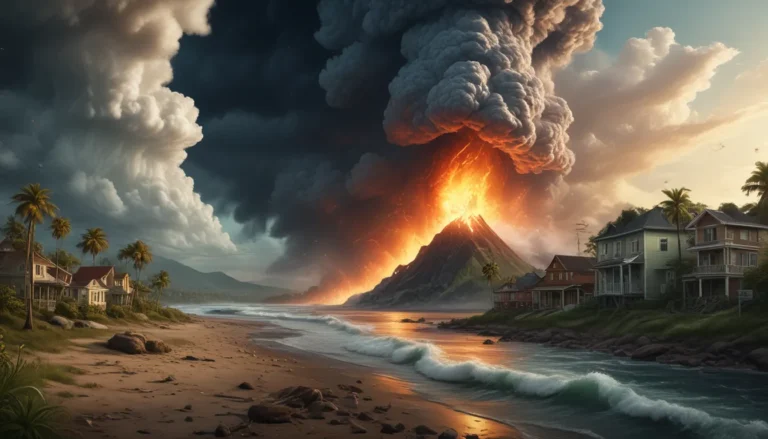A Note About Images: The images used in our articles are for illustration purposes only and may not exactly match the content. They are meant to engage readers, but the text should be relied upon for accurate information.
Hotspots, a captivating geological phenomenon, offer a glimpse into the dynamic nature of our planet. These fixed spots of intense volcanic activity have shaped Earth’s surface in astonishing ways, from creating volcanic islands to influencing continental rifting. In this article, we will delve into 12 astonishing facts about hotspots, shedding light on their origins, impact on landscapes, and role in plate tectonics. Join us on a journey through the mesmerizing world of geological hotspots and uncover the mysteries they hold.
Understanding Hotspots: Unraveling the Geological Marvels
- Hotspots are fixed locations of intense volcanic activity, defying conventional movement of tectonic plates.
- Fueled by mantle plumes, hotspots can be found under oceans and continents, shaping Earth’s surface over millions of years.
Hotspots: The Mysterious Stationary Volcanic Regions
Hotspots, unlike most volcanoes that occur at plate boundaries, are stationary locations of intense volcanic activity. These geological marvels challenge the traditional movement of tectonic plates, offering a unique insight into Earth’s dynamic processes.
Chains of Volcanic Islands: The Legacy of Hotspots
As tectonic plates shift, hotspots remain fixed, giving rise to the creation of volcanic islands. Over time, as the plate moves away from the hotspot, a chain of islands forms, with the youngest volcanic activity occurring nearest to the hotspot.
The Hawaiian Islands: A Testament to Hotspot Power
The stunning Hawaiian Islands bear witness to the influence of hotspots on Earth’s surface. The ongoing volcanic activity on the Big Island of Hawaii is directly attributed to the hotspot beneath it, while older islands towards the northwest have gradually eroded over time.
Hotspot Marvels: Unveiling Extraordinary Geological Features
- Hotspots can trigger continental rifting, leading to the formation of rift valleys.
- Yellowstone Hotspot in the U.S. showcases supervolcano characteristics, with its last major eruption occurring approximately 630,000 years ago.
Hotspots: Agents of Continental Rifting and Submarine Volcanoes
In rare cases, hotspots can initiate the splitting of continents, resulting in the formation of rift valleys. Examples like the East African Rift System highlight the role of hotspots in shaping Earth’s landscapes. Moreover, hotspots can also be found beneath oceanic plates, giving rise to submarine volcanoes and seamounts.
The Yellowstone Supervolcano: A Hotspot Spectacle
The Yellowstone hotspot, located beneath Yellowstone National Park in the U.S., stands as a prime example of a hotspot displaying supervolcano characteristics. Its history of major eruptions underscores the immense geological forces at play within hotspots.
Landscape Shapers: Hotspots’ Lasting Impact on Earth
Over prolonged periods, hotspots produce volcanic activity that significantly shapes landscapes. Unique formations like calderas, lava fields, and volcanic cones left behind by hotspots contribute to the geological diversity of regions, showcasing the enduring impact of these dynamic phenomena.
Unveiling the Mysteries of Hotspots: Insights and Discoveries
- By studying the age progression of islands or volcanic features linked to hotspots, scientists gain valuable insights into plate motion dynamics.
- Hotspots can occur within continental interiors, as evidenced by volcanic activity in regions like Yellowstone and the Eifel in Germany.
Mantle Plumes: The Lifeline of Hotspots
Mantle plumes, areas deep within Earth’s mantle, play a crucial role in fueling hotspots. These regions of abnormally hot and buoyant material rise up, supplying the heat and magma necessary for hotspots to sustain volcanic activity. The mechanisms behind mantle plumes continue to be a subject of scientific inquiry.
Galapagos Islands: A Hotspot Haven of Biodiversity
The unique Galapagos Islands, renowned for their diverse wildlife, owe their origins to a hotspot beneath the Pacific Ocean. The volcanic activity associated with this hotspot has been instrumental in creating the distinct geology and ecosystems found on these captivating islands.
Volcanic Provinces: Testimony to Hotspot Persistence
Through continuous lava eruptions over millions of years, hotspots can form extensive volcanic provinces. Notable examples include the Deccan Traps in India and the Siberian Traps in Russia, showcasing the enduring impact of hotspots on Earth’s geological landscape.
Embarking on a Geological Exploration: Unraveling the Beauty of Hotspots
Hotspots stand as fascinating geological wonders that have played a crucial role in shaping Earth’s surface over millennia. The extraordinary facts about hotspots underscore their significance in understanding plate tectonics, volcanic activity, and the ever-changing nature of our planet’s geology.
In Conclusion: Hotspots – Nature’s Geological Marvels
Hotspots in geology represent dynamic and captivating features that continue to shape our planet. The 12 astonishing facts about hotspots highlight their role in forming volcanic islands, creating unique ecosystems, and influencing tectonic plate movements. From the majestic Hawaiian Islands to the awe-inspiring Yellowstone hotspot, these regions spark curiosity and inspire exploration into Earth’s geological history. As we delve deeper into the mysteries of hotspots, we gain a deeper appreciation for the forces that have sculpted our world throughout time.
FAQs: Unveiling the Truth Behind Hotspots
Q: What is a hotspot in geology?
A hotspot in geology is a location on Earth’s surface where a plume of hot mantle material rises up and generates volcanic activity.
Q: How do hotspots form volcanic islands?
As the tectonic plate moves over the stationary hotspot, a chain of volcanic islands is created. The oldest island is farthest from the current hotspot location, while the youngest island is directly above it.
Q: Are hotspots responsible for all volcanic activity?
No, not all volcanic activity is attributed to hotspots. Many volcanoes are linked to tectonic plate boundaries where subduction or rifting processes occur.
Q: Can hotspots cause earthquakes?
While primarily associated with volcanic activity, hotspots can also produce seismic activity, including earthquakes, especially when located near tectonic plate boundaries.
Q: Are hotspots permanent features?
Hotspots are not permanent as they move with the shifting of tectonic plates, leading to changes in their location and potential new volcanic activity elsewhere.
Unravel the mysteries of hotspot geology and dive into the wonders of Earth’s dynamic processes, all waiting to be explored and understood. Join us as we embark on a journey through the captivating world of hotspots, witnessing their transformative power on our planet’s ever-evolving landscape.






